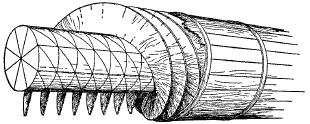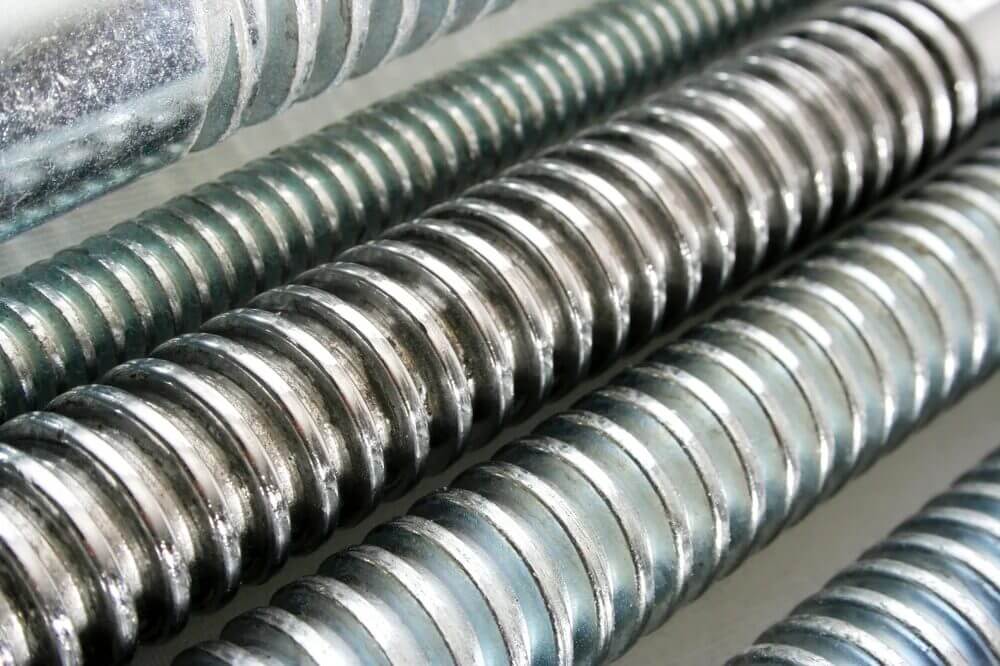Thread (drives) are like other technical areas these days: lots of information, often scattered and rarely clearly summarized. You lose track and quickly feel lost and overwhelmed by the mass of data and facts. One-sided understanding also often plays a role in the flood of information. Many people only see the external thread of a screw when they hear the word thread. However, screw drives have other characteristic distinguishing features and far more possible applications. So there is more to this everyday object than most people realize.
We encounter threads (drives) far more often in our everyday lives without obviously seeing or noticing them. One good reason for this is the fact that many people are not even aware of where they are used. Yet they are little marvels that make many things easier and often more pleasant for us.
To counteract this flood of information, we would like to use our expertise to pass on concentrated knowledge in an easily understandable way. Let's start here in the first part of our blog series with a digression into history.
Where do thread (drives) actually come from?
If you search for the historical origins of the screw - and therefore the thread - you will come across different statements. However, a closer look reveals that there are basically two areas of origin: Firstly, the screw principle, which used the screw for conveying and pressing, and secondly, the screw as a connecting element and fastener. The latter, however, has not been in use for nearly as long. In contrast, the screw principle was already known in ancient times. One of the most famous examples of this is the "Archimedean screw", also known as the screw pump or screw conveyor.

(Source: Wikipedia, Archimedes-screw_one-screw-threads_with-ball_3D-view_animated.gif created
by Silver wolf)
As a simple pumping system, the screw pump consists of a helix (a helical elevation that winds around a cylinder, ideally with a constant gradient) and a pipe in which the water is transported between two troughs, containers or levels. In ancient times, this invention was used for irrigation or drainage purposes to transport water to a higher level.
We therefore owe Archimedes (287 BC - 212 BC) not only the famous exclamation "Eureka!", which coined the Archimedean principle (the principle of displacement), but he also laid the foundation for today's screw drives and thus paved the way for many innovative products and applications.
What many people don't know, however, is that the term "snail pump" is actually misleading and therefore not entirely correct. Even though this term was coined in ancient times because of its similarity to the spiral-shaped sea shell, it is neither a snail nor a pump. This invention is actually a constant pressure lifting device. If you want to find out more about the exact specifications, you can read about them in DIN 1184 or in our Library of thread rolling 3/9.
The German term Schneckenpumpe was derived from the Dutch Vijzelpomp, partly because the Dutch are said to have been the biggest users of these in the last 500 years. Unfortunately, this theory has not yet been sufficiently substantiated and should therefore be treated with caution.
Let's summarize briefly. The first mention of a thread-like object can be traced back to around 3 centuries BC, but the screw is not a screw, it was a kind of pump, or rather a hoist. So how did things continue until we arrived at today's screw drive in its present form?
The antique screw: a hoist and not a pump
As the name "Archimedes' screw" suggests, this invention is attributed to the Greek mathematician and technician Archimedes. Of course, there are researches and theories that say that something similar has been used by mankind before. For example, the water screws in ancient Egypt or Archytas of Tarentum (435/410 -355/350 BC), who is considered the inventor of mechanics, are mentioned here.
One of the first precise details on the construction of such a screw pump can be found in a work by the Roman architect, engineer and architectural theorist Vitruvius (1st century BC). To be more precise, in the 10th volume of his work "Ten Books on Architecture" (originally "De architectura libri decem"), the volume that deals with the subject of mechanical engineering. The specifications listed there describe the exact relationship between the individual (construction) parts, their assembly and handling, which is not explained in such detail. However, there are relics from this period that show the drive by human power.

If you would like to take a closer look at the topic and read more about it,
we recommend:
1 John Gray Landels: Engineering in the Ancient World. Beck, Munich 1979, ISBN 3-8289-0362-2, Chapter 3: Water pumps (title of the original English edition: Engineering in the Ancient World. Chatto & Windus, London 1978).
2. ↑ Friedrich Klemm: History of technology. 3rd edition. Teubner, Stuttgart, Leipzig 1998, p. 38 f.; Helmuth Schneider: Geschichte der antiken Technik. Beck, Munich 2007, pp. 45-47.
(Source of the references Wikipedia, here the link to the article of the Archimedean Screw).
If we take a closer look at the Archimedean screw, the thread-like shape is particularly striking. The shape that is also used in today's screws and threads. It is a connecting element that can be used to create both fixed and detachable fastenings. Their first proven use as this fastening element can be found among the Romans. Even if the areas of application for screws there were far less diverse than today, they were already used in medical devices and astronomical instruments back then. (Here the link to the topic of ball screws in astrophysics and here more about the use of ball screws in the medical field today).
From Archimedes' screw to the well-known connection technology
Very early on, people realized that this connection technology could be used to convert a rotational movement into a longitudinal movement. A good example of this are ancient construction cranes as well as wine and oil presses, which made use of the amplification of forces by means of threads and nuts.

As the variety of applications grew, so did the materials used and the manufacturing processes and equipment for them.
While silver or bronze was used by the Romans depending on the application, wood was used for the aforementioned wine or oil presses. It should be emphasized here that care had to be taken to ensure that the wood had a certain strength to prevent it from breaking during use.
Unfortunately, the thread as a movement element largely disappeared during the Middle Ages and other drive options were used.
And drive is a good keyword for the next historical stage. Many people only associate the "Renaissance" with the cultural epoch in Europe that spanned three centuries. But it was also the "rebirth" of many achievements from Greek and Roman antiquity and thus the reappraisal of many inventions from this period.
One of the most famous representatives of this era, who must be mentioned in connection with the historical development of screw drives, is Leonardo da Vinci (1452-1519), painter, sculptor, architect, anatomist, natural philosopher, mechanic and, last but not least, engineer. He is the author of one of the oldest known records of a tool used to cut a thread.
He worked extensively on the various possible applications of threads. During his lifetime, he also created many sketches of moving and fastening screws that are still preserved today.
What many people are unaware of in this context is that the use of the screw has also been discussed in detail in German-speaking countries.
The German physician, pharmacist and scientist Georgius Agricola, also translated from Latin as Georg Bauer (1494 -1555), is considered one of the most outstanding Renaissance scholars of his time. His work and expertise covered many areas in the natural sciences and humanities. What makes him so interesting for us, however, are his texts and illustrations of threads and screw systems, which were created with such great attention to detail that they were even suitable for replicas.
The long road to the ISO thread
With the beginning of the industrial revolution, the machine production of nuts and bolts also began. What previously had to be produced laboriously by hand could now be manufactured more efficiently, more quickly and more cheaply in screw factories. This was the cornerstone for further expansion, as the steadily increasing demand could now be better met.
What is interesting to mention here is that thread cutting gauges or plates, used in lathes, for the manufacture of nuts and bolts already existed in France in 1568 (built by Besson), but it was not until 100 years later that they were improved and adapted by the English company Hindley of York.
In 1760, the brothers Job (John, depending on the source) and William Wyatt introduced a manufacturing process or machine for the mass production of screw threads. What was intended for wood screws was applied to iron screws. Unfortunately, despite their patent, the two were not successful and had to close their company after just a few years. Nevertheless, they created a milestone in the history of the production of screws and thus of threads.
With the development of machines that improved and accelerated the processes, new materials were used. This was accompanied by the invention of material testing machines during this time, which meant that higher quality materials could now be used for production.
As production was different in every country and every factory, there were also differences in size, material and properties. It became necessary to introduce standardized quality features and thread dimensions.
As early as 1841, the Englishman Joseph Whithworth advocated the standardization of all screw threads in England, but this did not yet become established throughout Europe. The VDI (Association of German Engineers) took over the development of guidelines in Germany in 1859, which defined regulations for quality, material, a standardized thread size and its properties.
It was not until 1948 that an agreement was reached between Great Britain, the USA and Canada regarding the use of imperial units of measurement for screws. The ISO thread was then standardized worldwide in 1964.

(Source Adobe Stock)
The end of a long journey
There has been a long and impressive journey behind this, for many trivial, object, yet the technology and areas of application are constantly evolving.
We at Eichenberger are also constantly evolving, because we challenge the limits of what is technically feasible for our customers. Regardless of whether the installation space is to be optimized, the dynamics increased, the energy efficiency improved, the weight reduced, the service life increased or the costs reduced, we develop the right screw drive solution with you to bring your innovation to the forefront of the market.
Would you like to optimize your drive solution? We support you in the realization of your perfect drive solution. Learn more here how we can help you.
Outlook for part 2 of our small thread (drive) school
- What happens next?
Now you have learned a lot about the origin of the screw and therefore also the thread. But the topic of threads offers even more interesting facets and interesting facts. Learn more interesting facts about thread rolling here. And learn more about the basics, processes, tools and applications of rolled high-tech threads.
In the next part, we will look at the question of what a screw drive is, what makes it special and what forms exist.


